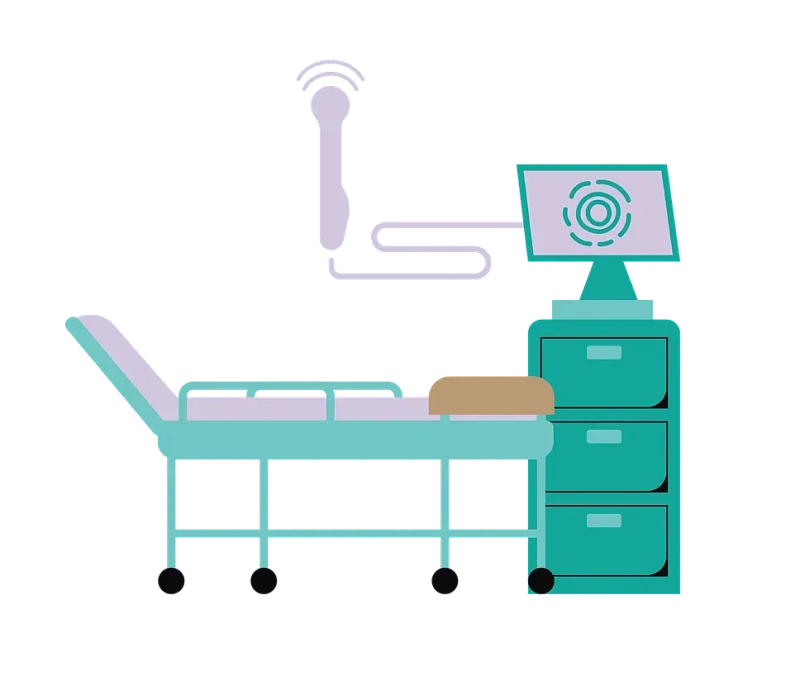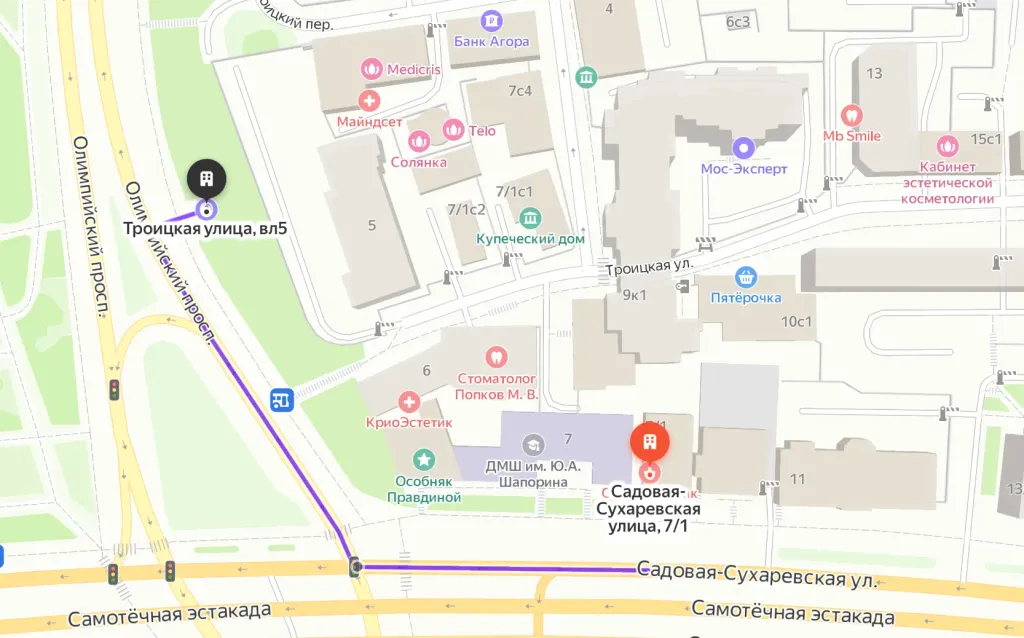Colonoscopy
Colonoscopy is a research method in which a doctor uses endoscopic equipment to visually assess the condition of the mucous membrane of the colon and terminal ileum.

Due to the high diagnostic accuracy, colonoscopy allows timely detection and removal of both precancerous changes in the mucous membrane (polyps) and malignant changes in the early stages of the disease (the so-called "early cancer").
During colonoscopy, other changes in the mucous membrane can be diagnosed, such as inflammatory processes, erosive and ulcerative lesions, and neoplasms. As part of colorectal cancer screening, colonoscopy is recommended for patients over 40 years of age (even if there are no complaints). It is also important for people who have a hereditary predisposition to colon cancer to undergo this procedure.
Preparation for the procedure begins 3-5 days before the examination. At this time, you need to follow a special diet with the exception of vegetable fiber. On the eve or on the day of the procedure (depending on the time of the start of the examination), it is necessary to start taking a drug that cleanses the intestine. It is important to follow all the preparation steps described in the memo. Poor-quality preparation reduces the diagnostic accuracy of colonoscopy and may require repeated examination for a more detailed examination.
The study is conducted under conditions of drug-induced sleep and takes about 30-40 minutes on average. The doctor carefully guides the endoscope through the rectum to the level of the transition from the colon to the small intestine under the control of vision. During the study, a sequential examination of the mucous membrane of all parts of the colon is performed. If necessary, a biopsy or removal of polyps can be performed.
Olympus Clinic uses modern high-resolution video colonoscopes with a powerful optical system that allows detailed visualization of the intestinal mucosa.
Recovery occurs quickly — after a study conducted under conditions of drug-induced sleep, the patient stays in a separate comfortable room with a comfortable bed for 30-40 minutes, after which he can return to his usual lifestyle, eliminating driving on the day of the study. In case of removal of polyps, the doctor gives individual recommendations on nutrition and regimen.
Benefits
A minimally invasive approach
The procedure is performed through natural pathways, without requiring incisions or long-term recovery.
High information content
Colonoscopy gives a complete picture of the condition of the colon.
Therapeutic possibilities
You can not only diagnose, but also immediately fix some problems.
Comfort
Colonoscopy "in a dream" is painless for the patient.
Accurate diagnosis
The possibility of a detailed visual assessment of the mucous membrane of the colon and a targeted biopsy of a pathologically altered area.
Safety
Continuous anesthetic monitoring throughout the study.
Versatility
The possibility of performing not only diagnostics, but also therapeutic manipulations (polypectomy) during colonoscopy.
Specialists
Find a SpecialistIndications and contraindications
Indications
Abdominal pain of unclear etiology
Chronic pain, the cause of which cannot be determined using less invasive methods.
The presence of blood in the stool
A symptom that may indicate the presence of inflammation, ulcers, polyps, or colon cancer.
Prolonged diarrhea or constipation
Long-term changes in stool consistency.
Suspected colorectal cancer
Regular screening for colon cancer, especially in people over the age of 45 or those with a family history of colon cancer.
Expected effect
Accurate diagnosis
It allows you to accurately identify the causes of symptoms such as blood in the stool, chronic constipation or diarrhea.
Detection of polyps
The ability to detect and remove polyps before they can develop into cancer.
Relief of symptoms
Removing obstacles, such as large polyps, can immediately improve the patient's well-being.
Prevention of colon cancer
Regular colonoscopy reduces the risk of colorectal cancer.
How to reach
How to get
From the Belorusskaya metro station of the Zamoskvoretskaya line - exit 4 After exiting the subway, walk through the pedestrian tunnel and climb the stairs. Move towards the railway tracks, go down the stairs immediately after them and walk along the house, then turn right onto 1st Yamskoye Pole Street. At the turn to 3rd Yamsky Pole Street, cross the road at the pedestrian crossing and continue along 1st Yamsky Field Street, after a few buildings on the left you will see Olympus Clinic MARS.
Travel time
9 minutes
Landmark
Olympus Clinic MARS sign
How to get
From the Belorusskaya metro station of the Ring line - exit 2. After exiting the subway, turn left and walk to the pedestrian crossing. Cross the road through two pedestrian crossings and move along the Tverskoy overpass. Go down the stairs immediately after the railway tracks, walk along the house, then turn right onto 1st Yamskoye Pole Street. At the turn to 3rd Yamsky Pole Street, cross the road at the pedestrian crossing and continue along 1st Yamsky Field Street, after a few buildings on the left you will see Olympus Clinic MARS
Travel time
11 minutes
Landmark
Olympus Clinic MARS sign
From the metro station "Tsvetnoy Bulvar"
1 exit to the city, then left to the Garden Ring, at the crossing to the right, crossing the boulevard, one more crossing and at the traffic light to the left. The Olymp Clinic building is located overlooking the Garden Ring to the right of the crossing. Travel time is approximately 9 minutes. Landmark - sign Olymp Clini
From the metro station "Sukharevskaya"
Exit 3 from the metro and 640 meters straight ahead, the clinic will be on the right. Landmark - sign Olymp Clinic
Parking lot map
Exit 3 from the metro and 640 meters straight ahead, the clinic will be on the right. Landmark - sign Olymp Clinic

From Sokol metro station
The last car from the center: follow the signs for Exit 5. From the glass doors to the right and go to the end of the passage. Exit to the city by the steps to the left. After exiting the crossing to the street, go straight along Leningradsky Prospekt to the intersection with Chapaevsky Lane. Next, turn right (onto Chapaevsky Lane) and walk to the Triumph Palace residential complex. Entrance to the territory: through checkpoint No. 1, opposite the Vkusville store, you will need to present your passport. After passing through the checkpoint, go up the stairs to the fountain, opposite it you will see our clinic.
Travel time
10-12 minutes
From the Airport metro station
The first car from the center: follow the Exit 2-3 signs. Turn left out of the glass doors and walk to the end of the passage. After exiting the crossing to the street, go straight along Leningradsky Prospekt to the intersection with Chapaevsky Lane. Next, turn left (onto Chapaevsky Lane) and walk to the Triumph Palace residential complex. Entrance to the territory: through checkpoint No. 1, opposite the Vkusville store, you will need to present your passport. After passing through the checkpoint, go up the stairs to the fountain, opposite it you will see our clinic.
Travel time
12-15 minutes
How to get
Entry to the territory is prohibited, but there are free city parking lots around the Triumph Palace residential complex, where you can easily find a place for your car. Free parking area:



